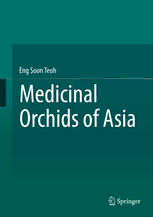
Medicinal Orchids of Asia PDF
Preview Medicinal Orchids of Asia
Eng Soon Teoh Medicinal Orchids of Asia Medicinal Orchids of Asia ThiSisaFMBlankPage Eng Soon Teoh Medicinal Orchids of Asia EngSoonTeoh,M.D.,F.R.C.O.G.,F.A.C.S. Singapore Singapore ISBN978-3-319-24272-9 ISBN978-3-319-24274-3 (eBook) DOI10.1007/978-3-319-24274-3 LibraryofCongressControlNumber:2016947012 #SpringerInternationalPublishingSwitzerland2016 Thisworkissubjecttocopyright.AllrightsarereservedbythePublisher,whetherthewholeor part of the material is concerned, specifically the rights of translation, reprinting, reuse of illustrations,recitation,broadcasting,reproductiononmicrofilmsorinanyotherphysicalway, andtransmissionorinformationstorageandretrieval,electronicadaptation,computersoftware, orbysimilarordissimilarmethodologynowknownorhereafterdeveloped. Theuseofgeneraldescriptivenames,registerednames,trademarks,servicemarks,etc.inthis publicationdoesnotimply,evenintheabsenceofaspecificstatement,thatsuchnamesare exemptfromtherelevantprotectivelawsandregulationsandthereforefreeforgeneraluse. Thepublisher,theauthorsandtheeditorsaresafetoassumethattheadviceandinformationin thisbookarebelievedtobetrueandaccurateatthedateofpublication.Neitherthepublishernor the authors or the editors give a warranty, express or implied, with respect to the material containedhereinorforanyerrorsoromissionsthatmayhavebeenmade. Printedonacid-freepaper ThisSpringerimprintispublishedbySpringerNature TheregisteredcompanyisSpringerInternationalPublishingAGSwitzerland Dedicated to my wife Teoh Phaik Khuan ThiSisaFMBlankPage Preface Rebecca Northern’s Home Orchid Growing provided recreational reading when I was studying for myprofessional examination inLondon in1968. I continuetoenjoyreadingaboutorchidsandgrowingtheplants.Noticingthat orchids are now receiving attention as possible sources of medicinal compounds, I decided to study this area in depth because, having been privileged to participate in laboratory and clinical research for many years, I could employ my medical background to examine the extensive research that has been conducted on the use of orchids as medicine. There is maxi- mum,continuoususageoforchidsasmedicineinAsia,forthelongestperiod, and because Asia is my home, and also the area of much of my travel, the coverageofmedicinalorchidspecieswillberestrictedtothisregion. Beforetheadventofscientificmedicine,allcivilizationsreliedonplants andothernaturalmaterialstocopewithpain,traumaanddisease.Dominance and sex being important elements of Man’s animal heritage, plants with alleged invigorating or aphrodisiac properties were eagerly sought after. Growth hormone, testosterone, sidenafil and tadalafil are only modern substitutesformuchthesameneed. Herbal medicine is practised worldwide, and not in Asia alone. In many continents,orchidshavebeenusedtonourishortoheal.Salep derivedfrom terrestrial Mediterranean orchids and extracts of North American CypripediumsfeaturedinEuropeanandAmericanpharmacopoeiawellinto thelaternineteenthcentury.Nevertheless,usingorchidsasmedicineismost entrenchedinChina,whichhasawell-documentedandthelongesthistoryof continuous usage, as well as the longest list of orchids in medicinal use. Worldwide, there are over 25,000 species in approximately 850 genera but only 2 % have a published medicinal usage. It is estimated that approxi- mately1200speciesoforchidsbelongingto174generaoccurinChina.More than250species(orover20%oftotalspecies)inapproximately100genera are already recorded in Chinese herbals as having medicinal usage. Four orchidsareclassicalmedicinalherbswhoseoriginscanbetracedtoantiquity. TheyarestillcommonlyemployedintheOrient,fromChinatoKorea,Japan and Southeast Asia, and by Chinese communities in far-flung countries. Chineseherbalsoupsoccasionallycontainanorchid. Orchids also feature in Ayurvedic medicine. They constitute half of the eightitemsinthefamedAsthvarghatonic.NearlytwodozenIndianmedici- nalnamesareattachedtoDendrobiumplicatile,manyofwhichdenote“life”. It is one of two candidates that fulfil the description of a mysterious vii viii Preface Himalayan herb that restored life to the Ramayana hero, Lakshmana. Truckloads of this orchid are imported into India from neighbouring countries. Tribes in India and the surrounding countries employ orchids in variouswaystotreattraumaanddisease. Having experienced a shortage of medicines during World War II, after the war scientists embarked on an extensive search for alkaloids in plants. Therewassomedifficultyinstudyingalkaloidsinorchids because rarityor smallplantsizesometimesmadeitdifficulttocollectsufficientmaterialsfor theidentificationofchemicalcompounds.Nevertheless,thisdidnotdeterthe SwedishteamledbyBjornLuningandKurtLeanderortheAustralianteam of Slaytor and Walker from undertaking alkaloid screening programmes. Together, by 1994 they had published the data on 1750 orchid species. Japanese, Chinese and Korean scientists were more interested in studying orchidspeciesemployedintraditionalChinese,JapaneseandKoreanmedi- cine. There are extensive publications on phytochemicals from Gastrodia elata,Dendrobiumspp.andBletillastriata. Forced to rely on its own resources to promote the health of its people whenthe“BambooCurtain”descendedoverthePeoples’RepublicofChina, thecountryundertookanextensivein-depthstudyofethno-medicinewhich hitherto had only been provincial or tribal knowledge. In the process, hundreds of orchid species were incorporated into an expanded Ben Cao (MateriaMedica).Byunveilingthereproductivebiologyandpharmacology ofimportant medicinal species,scientists inGuizhouandYunnanmanaged to promote the cultivation of such species on an industrial scale and to manufacturespecificcompoundstomeetwithdemand. As a consequence of the remarkable economic and scientific advances madebyChinaduringthelastthreedecades,traditionalChinesemedicineis witnessing an interphase between tradition and science, with science dominating the transition. Concurrently, there has been an explosion of publications, including many on orchids. Several traditional medicinal orchids have since been shown to contain compounds that exert a wide range of pharmacological effects. Some compounds are unique in their actions, some are capable of protecting brain cells, while a few act against malariaparasitesorliverflukes.Orchidextractsmayprotecttheskinorliver. There arecompounds thatkillcancercells,whileothers reverse cancer cell resistancetochemotherapeuticagents.Bletillastriatastarchisemployedfor embolizationtotreatinoperablelivercancerandisbeingdevelopedtoassist in the delivery of drugs. Such compounds are being actively studied to determinewhethertheycanbeturnedintopotentdrugs. Therearemanystudiesonethno-medicineinIndia,butuntiltheadventof the internet knowledge of the subject was mainly confined to the nation. In Calcutta, Majumder and his team of collaborators isolated a long list of compounds from numerous Himalayan orchids. Korean scientists have also investigated the pharmacology of their orchids. However, it is difficult to extract these data because they are either not available in the English language or they are published in journals which are not read by doctors, Preface ix nor by orchid enthusiasts with no interest in pharmacology. Research materials originating in China and Japan are mostly recorded in journals whichemploytheirnativelanguagesandsuchdatamayremainunnoticedby Westernreadersfordecades.Iamfortunatetohavebeenhelpedbymedical colleagueswhohavemasteredtheChineselanguage.Theyprovidedmewith thenecessarysupportthathasenabledmetoresearchtheChineseliterature. This volume thus sets out to compile a list of the medicinal orchids employed in Asia, briefly describe their identification, distribution, habitat andfloweringseason,howtheyareusedandtheirpharmacology.Medicinal orchid species are described individually, grouped under genera. An over- view sums up and discusses the research findings in each genus. Clinical information is occasionally included when it was necessary to explain the significance of the research data. Findings that hold promise of possible therapeuticapplicationarehighlighted. TheIntroductiongivesanoverviewofherbalmedicine,itsrole,theextent of its usage and the risks involved. Since many Western readers may be unfamiliar with Asian medicinal tradition, the various traditions are described, followed by a discussion of the way herbs are collected and prepared. Abrief survey of plant metabolites is intended as an introduction forthegeneralreadertothetypesofbioactivechemicalcompoundsisolated from orchids in which scientists are interested. Currently, the effects of medicinalorchidspeciesarebeingprovenbylaboratoryresearchontissues or laboratory animals, but there is a paucity of data on human subjects. Nevertheless, this is a beginning. A placebo-controlled randomized clinical trialbeingthegoldstandardtoproveefficacyofanynewdrug,achapteris included to emphasize that it would be difficult, today, to endorse a herbal remedy without such experimental proof. A short final chapter explains the difference between anecdotal evidence and data which are statistically significant. TheuseoforchidsasaphrodisiacsinIndia,andthehighChinesedemand forsomemedicinalorchids,worryconservationistswhoareconcernedabout thestatusofwildorchidsinIndia(especiallyintheHimalayanregion),China and continental Southeast Asia. Conservation, the preservation of biodiver- sityandproblemsintheenforcementarediscussedindetail. Iwishtostressthatthisbookwasnotwrittentoendorsetheuseoforchids as medicinal herbs. I do not practise Chinese herbal medicine. Scientific researchonmedicinalorchids,althoughextensiveandexciting,isstillatan earlystage,anditisinappropriatetodrawclinicalinferencesorconclusions frominvitrostudiesandanimalexperiments.Muchremainstobedonetosee thatproperclinicaltrialsareconductedtosubstantiateordisprovetheclaims forspecifictherapeuticusesofindividualorchidsortheircompounds.Ihave kept an open mind on the subject, and I have tried to be impartial in my assessments of published articles. The claims that are made in the quoted publications are reported as they appear and no attemptwas made to check theirvalidity.Ontheissueoftribalandfolkmedicine,itseemsunlikelythat theauthorsactuallywitnessedtheorchidstheydescribedbeingusedtotreat disease and the results, as ethnomedicinal botany is basically constituted fromstatementsoffolkpractitioners.Thisbeingso,theportionofthepresent
